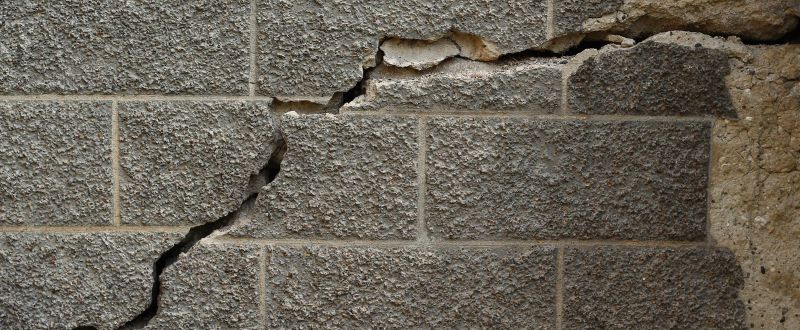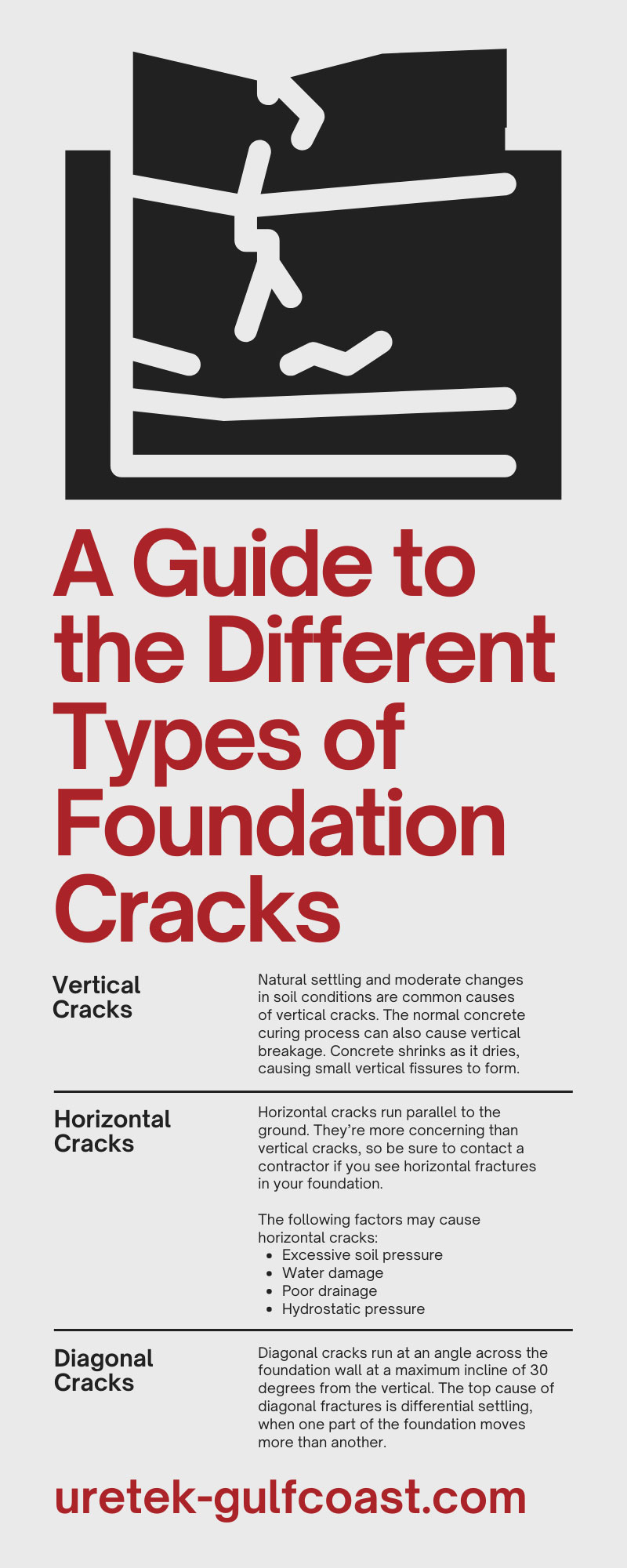A solid foundation is crucial for a building’s stability and moisture resistance. However, foundations can develop cracks that compromise these structural and protective characteristics over time.
Understanding the various types of foundation cracks can help property owners recognize possible problems before they escalate into major issues. Learn more about foundation fissures, their causes, and how to fix them with this guide to the different types of foundation cracks.
Understanding Shrinking and Expanding Soil
Since changes in the soil are often the cause of foundation fractures, it’s important to understand what causes soil to shrink and expand. The US has many soil types that respond differently to moisture content.
Houston Black soil is a distinctive vertisol, a type of soil rich with clay. Houston Black soil swells when wet and contracts when dry. This high shrink-swell potential can wreak havoc on foundations.
Swelling pressures can cause a foundation to heave or lift. Shrinking can cause the foundation to settle or move downward.
Vertical Cracks
Vertical cracks run up and down the foundation wall. They are one of the most common types of foundation cracks.
Natural settling and moderate changes in soil conditions are common causes of vertical cracks. The normal concrete curing process can also cause vertical breakage. Concrete shrinks as it dries, causing small vertical fissures to form.
What To Do
Narrow vertical breaks that do not change may only require light repair, such as filling with epoxy or polyurethane crack injection. Filling the crack will prevent water and bugs from entering the structure. Fissures wider than 1/8-inch and growing cracks may need to be evaluated by a foundation professional to determine the best course of action.
Horizontal Cracks
Horizontal cracks run parallel to the ground. They’re more concerning than vertical cracks, so be sure to contact a contractor if you see horizontal fractures in your foundation.
The following factors may cause horizontal cracks:
- Excessive soil pressure
- Water damage
- Poor drainage
- Hydrostatic pressure
Moisture accumulating in the soil surrounding the foundation causes hydrostatic pressure. The waterlogged soil expands, exerting pressure that breaks the concrete.
Recommended Action
Consult a professional contractor immediately if you notice horizontal cracks. Serious foundation problems can cause issues like sinking, uneven flooring, poor insulation, and flooding.
Diagonal Cracks
Diagonal cracks run at an angle across the foundation wall at a maximum incline of 30 degrees from the vertical. The top cause of diagonal fractures is differential settling, when one part of the foundation moves more than another.
What To Do
Small, hairline diagonal cracks may not require immediate action, but you should monitor these cracks for changes. As with vertical cracks, you can repair many diagonal fissures with epoxy crack injection.
Foundation settling typically causes slanted cracks that are wider at the top and narrower at the bottom. Call a professional to assess these cracks or cracks that are wider than 1/8 inch.
Stair-Step Cracks
Concrete blocks and brick walls above the foundation are prone to stair-step cracks. These fissures form in the mortar. Foundation movement and expansion and contraction of building materials may cause stair-step cracks.
These fractures don’t threaten the stability of a home to the same degree as horizontal cracks. However, they can let pests and moisture in, and without intervention, they may worsen and cause more significant problems.
Recommended Action
Call a contractor for an inspection if the crack is wider than 1/4 inch. Caulking or applying more mortar will make the bricks look temporarily better. However, the fracture will eventually reappear if you don’t address the root cause.
Cracks in the Building’s Interior
As this guide to the different types of foundation cracks shows, it’s important to consider the fissure’s direction, width, and changes over time. Cracks on interior walls may also indicate foundation problems that require intervention. Continue reading to learn the differences between cosmetic imperfections and symptoms of structural issues.
Hairline Cracks
Hairline cracks are thin, uniform cracks that are extremely narrow. Sometimes, you’re barely able to see them. People also call them surface cracks because they do not penetrate deeply into the wall.
Concrete’s curing process, minor settlement, temperature fluctuations, and building materials drying out may also cause hairline fractures. They can form in the days or weeks after a construction crew creates a new foundation. In older homes, hairline cracks result from aging but do not necessarily indicate a serious problem.
What To Do
As with most vertical, stair-step, and diagonal fissures, hairline cracks do not often indicate an immediate threat to the building’s structural support. However, you must monitor them for changes. If they widen or more cracks form, request an inspection as soon as possible.
Cracks From the Wall to the Ceiling
Drywall cracks are not unusual, and they often do not indicate a problem with the foundation. For example, cracks in wall corners are usually caused by shifting framework that does not have adequate fasteners. Drywall screws can fix such a problem.
However, cracks that radiate from the wall to the ceiling may be a symptom of problematic foundation movement. Cracks that run at an angle, such as 30 or 45 degrees, are also more likely to indicate a foundation problem.
Recommended Action
If the cracks are narrow and do not change, you may only need to repair the underlying material. However, you should request an inspection if these cracks are wide or grow larger.
Suitable Foundation Repair Requires Local Expertise
Your building’s location determines the type of foundation used and the stressors acting on your foundation. Your local climate, soil composition, seismic activity, and other geographic factors impact your maintenance needs.
Houston Conditions That Affect Foundations
As we’ve already shared, Houston Black soil is rich in clay with a high shrink-swell potential. When the soil is dry, it forms cracks; when wet, it expands. This dramatic change often causes significant foundation movements.
Houston’s hot, humid climate also affects foundations. Frequent rain and heat constantly widen and contract the soil. The environment can also worsen existing foundation cracks with water seepage and weathering.
Call URETEK ICR Gulf Coast for foundation repair in Houston. We specialize in performing URETEK Method® foundation repairs that are cost-effective and minimally invasive.
The sooner you address possible foundation issues, the easier the repairs will be. Contact us today for free foundation repair estimates.


